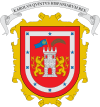Huejotzingo
| Huejotzingo | ||
|---|---|---|
| City & Municipality | ||

Facade of the monastery of San Miguel Arcángel
|
||
|
||
| Location in Mexico | ||
| Coordinates: 19°09′43″N 98°24′23″W / 19.16194°N 98.40639°WCoordinates: 19°09′43″N 98°24′23″W / 19.16194°N 98.40639°W | ||
| Country |
|
|
| State | Puebla | |
| Founded | 1529 (Spanish settlement) | |
| Government | ||
| • Municipal President | Felipe Juan Andrés Gorzo Ortega | |
| Area | ||
| • Municipality | 188.91 km2 (72.94 sq mi) | |
| Elevation (of seat) | 2,260 m (7,410 ft) | |
| Population (2005) Municipality | ||
| • Municipality | 59,822 | |
| • Seat | 23,826 | |
| Time zone | Central (US Central) (UTC-6) | |
| • Summer (DST) | Central (UTC-5) | |
| Postal code (of seat) | 74160 | |
| Area code(s) | 227 | |
| Website | Website | |
Huejotzingo (![]() modern Nahuatl pronunciation is a small city and municipality located just northwest of the city of Puebla, in central Mexico. The settlement’s history dates back to the pre-Hispanic period, when it was a dominion, with its capital a short distance from where the modern settlement is today. Modern Huejotzingo is located where a Franciscan monastery was founded in 1525, and in 1529, the monks moved the indigenous population of Huejotzingo to live around the monastery. Today, Huejotzingo is known for the production of alcoholic apple cider and fruit preserves, as well as its annual carnival. This carnival is distinct as it centers on the re-enactment of several historical and legendary events related to the area. The largest of these is related to the Battle of Puebla, with about 2,000 residents representing French and Mexican forces that engage in mock battles over four days.
modern Nahuatl pronunciation is a small city and municipality located just northwest of the city of Puebla, in central Mexico. The settlement’s history dates back to the pre-Hispanic period, when it was a dominion, with its capital a short distance from where the modern settlement is today. Modern Huejotzingo is located where a Franciscan monastery was founded in 1525, and in 1529, the monks moved the indigenous population of Huejotzingo to live around the monastery. Today, Huejotzingo is known for the production of alcoholic apple cider and fruit preserves, as well as its annual carnival. This carnival is distinct as it centers on the re-enactment of several historical and legendary events related to the area. The largest of these is related to the Battle of Puebla, with about 2,000 residents representing French and Mexican forces that engage in mock battles over four days.
The Franciscans founded the monastery of San Miguel Arcángel in 1525, in an area outside of the pre-Hispanic settlement of Huejotzingo. That settlement was located on higher ground, closer to the slopes of Iztaccíhuatl, in what is now known as San Juan Loma. Its early founding makes it one of the oldest monasteries in the Americas, and one of the first four Franciscan monasteries established in New Spain. It was dedicated to the Archangel Michael, who would eventually become the patron of the Spanish settlement of Huejotzingo and is the current patron of the modern municipality.
The current building is the third to have been built on the site. The first was a very modest construction that lasted from 1524 to 1529. In 1529, the Franciscans under Juan de Alameda moved the indigenous settlement to an area next to the monastery. Legend states that it was because the friars were tired of making the climb to the indigenous village for evangelization purposes. It was likely, however, to take advantage of indigenous labor to construct a larger monastery. The first monastery was demolished and a second complex was built in its place between 1529 and 1539. However, this building would not survive either, except for old plans and part of a foundation and walls, which were found during renovation work in 1980. The third and current complex was begun in 1544 and completed in 1570, and built under the direction of Juan de Alameda. Construction ended when Alameda died, and he was buried in the monastery. In the colonial era, it was described as being as luxurious as the church of San Juan de los Reyes in Toledo and one of the most beautiful in Mexico. Since then, the complex has survived a number of earthquakes with little damage. In the 1990s, it became one of fourteen monasteries around the Popocatepetl volcano declared a World Heritage Site. The state of Puebla promotes tourism of the monastery through its "Franciscan Route," which connects it with other 16th-century Franciscan monasteries in Calpan and Cholula.
...
Wikipedia


